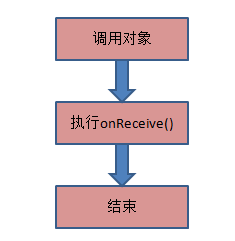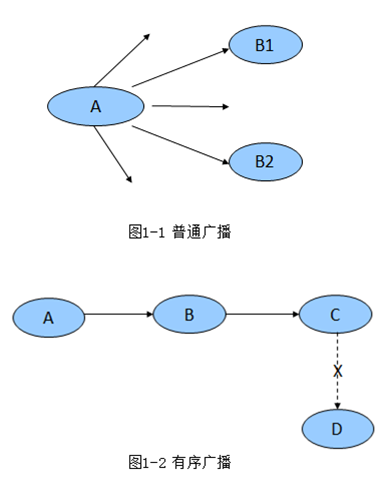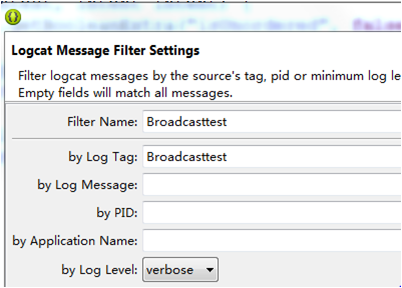BroadCastRecieve
首先介绍一下BroadCastRecieve有几种:
1.无序广播(普通广播):sendBroadcast()方式
2.有序广播:sendOrderedBroadcast()方式
3.粘性广播:sendStickyBroadcast()方式
生命周期比较简单:

下面是无序广播与有序广播的区别:




下面是普通广播(无序广播,有序广播)与粘性广播的区别:
sendBroadcast(intent); 发送之前必须注册广播,否则无法接收到广播信息。
sendStickyBroadcast(intent);发送广播后,注册也可收到广播信息。
首先看下一个无序广播,有序广播的例子:
package com.example.demo_broadcast2; import android.app.Activity;
import android.content.Intent;
import android.os.Bundle;
import android.view.View; public class MainActivity extends Activity { @Override
protected void onCreate(Bundle savedInstanceState) {
super.onCreate(savedInstanceState);
setContentView(R.layout.activity_main);
} /**
* 发送无序广播
*
* @param view
*/
public void send1(View view) {
Intent intent = new Intent();
intent.setAction("com.itheima.broadcasttest.songwennuan");
intent.putExtra("msg", "发1万块");
intent.putExtra("isUnordered", true);
// 无序广播,不可被拦截,不可终止
sendBroadcast(intent);
} public void send2(View view) {
Intent intent = new Intent();
intent.setAction("com.itheima.broadcasttest.songwennuan");
// 有序广播,可被拦截,可终止,可以修改数据
sendOrderedBroadcast(intent, null, null, null, 0,
"给农民兄弟发10000块钱", null);
}
}
send1,send2分别为点击事件触发时调用的函数分别为发送无序广播按钮,发送有序广播按钮。
activity_main.xml文件
<RelativeLayout xmlns:android="http://schemas.android.com/apk/res/android"
xmlns:tools="http://schemas.android.com/tools"
android:layout_width="match_parent"
android:layout_height="match_parent"
tools:context=".MainActivity" > <Button
android:onClick="send1"
android:layout_width="fill_parent"
android:layout_height="wrap_content"
android:text="发送无序广播" /> <Button
android:layout_width="fill_parent"
android:layout_height="wrap_content"
android:layout_alignParentLeft="true"
android:layout_alignParentTop="true"
android:layout_marginTop="51dp"
android:onClick="send2"
android:text="发送有序广播" /> </RelativeLayout>
下面依次是多个广播的实例(为了体现有序广播)
package com.example.demo_broadcast2; import android.content.BroadcastReceiver;
import android.content.Context;
import android.content.Intent;
import android.util.Log; public class Level1Receiver extends BroadcastReceiver {
private static final String TAG = "Broadcasttest"; @Override
public void onReceive(Context context, Intent intent) {
boolean isUnordered = intent.getBooleanExtra("isUnordered", false);
if (isUnordered) {
String message = intent.getStringExtra("msg");
Log.i(TAG, "省级部门得到中央的消息:" + message);
} else {
String message = getResultData();
Log.i(TAG, "省级部门得到中央的消息:" + message);
abortBroadcast(); // 这里是终止了消息,可以关闭或者取消这里查看LogCat中打印的效果。
setResultData("给农民兄弟发5000块钱"); // setResultData()方法,就是为了在有序广播中修改传到下一个广播中的值而存在的,且只能存储一个String.
} } }
package com.example.demo_broadcast2; import android.content.BroadcastReceiver;
import android.content.Context;
import android.content.Intent;
import android.util.Log; public class Level2Receiver extends BroadcastReceiver {
private static final String TAG = "Broadcasttest"; @Override
public void onReceive(Context context, Intent intent) {
boolean isUnordered = intent.getBooleanExtra("isUnordered", false);
if (isUnordered) {
String message = intent.getStringExtra("msg");
Log.i(TAG, "市级部门得到省级的消息" + message);
} else {
String message = getResultData();
Log.i(TAG, "市级部门得到省级的消息" + message);
setResultData("给农民兄弟发2000块钱");
} }
}
package com.example.demo_broadcast2; import android.content.BroadcastReceiver;
import android.content.Context;
import android.content.Intent;
import android.util.Log; public class Level3Receiver extends BroadcastReceiver {
private static final String TAG = "Broadcasttest"; @Override
public void onReceive(Context context, Intent intent) {
boolean isUnordered = intent.getBooleanExtra("isUnordered", false);
if (isUnordered) {
String message = intent.getStringExtra("msg");
Log.i(TAG, "乡级部门得到市的消息:" + message);
} else {
String message = getResultData();
Log.i(TAG, "乡级部门得到市的消息:" + message);
setResultData("给农民兄弟发两大大米");
}
} }
package com.example.demo_broadcast2; import android.content.BroadcastReceiver;
import android.content.Context;
import android.content.Intent;
import android.util.Log; public class FinalReceiver extends BroadcastReceiver {
private static final String TAG = "Broadcasttest"; @Override
public void onReceive(Context context, Intent intent) {
boolean isUnordered = intent.getBooleanExtra("isUnordered", false);
if (isUnordered) {
String message = intent.getStringExtra("msg");
Log.i(TAG, "农民兄弟得到乡的消息:" + message);
} else {
String message = getResultData();
Log.i(TAG, "农民兄弟得到乡的消息:" + message);
} }
}
首先我么线设置一下logcat如下:

接下来我们看一下效果:
当我们点击“发送无序广播”的时候效果如下:
可见只要我们发送一个广播,注册此广播的都会搜到相同的信息。

当我们点击“发送有序广播”的时候效果如下:
我们在Level1Receiver 中调用了一下方法截断了消息传输到下一个广播接收者。
abortBroadcast(); // 这里是终止了消息

如果我们把下面函数注释掉。
//abortBroadcast();
可见效果每个接收者接收到的数据都不一样这是因为我们通过一下函数向下发送了消息:
setResultData("给农民兄弟发2000块钱");

可见这是有顺序的,顺序是由广播接收者定义时可以设置优先级。代码可参考androidManifast.xml
<?xml version="1.0" encoding="utf-8"?>
<manifest xmlns:android="http://schemas.android.com/apk/res/android"
package="com.example.demo_broadcast2"
android:versionCode="1"
android:versionName="1.0" > <uses-sdk
android:minSdkVersion="8"
android:targetSdkVersion="17" /> <application
android:allowBackup="true"
android:icon="@drawable/ic_launcher"
android:label="@string/app_name"
android:theme="@style/AppTheme" >
<activity
android:name="com.example.demo_broadcast2.MainActivity"
android:label="@string/app_name" >
<intent-filter>
<action android:name="android.intent.action.MAIN" /> <category android:name="android.intent.category.LAUNCHER" />
</intent-filter>
</activity>
<receiver android:name=".Level1Receiver" >
<intent-filter android:priority="1000" >
<action android:name="com.itheima.broadcasttest.songwennuan" />
</intent-filter>
</receiver>
<receiver android:name=".Level2Receiver" >
<intent-filter android:priority="500" >
<action android:name="com.itheima.broadcasttest.songwennuan" />
</intent-filter>
</receiver>
<receiver android:name=".Level3Receiver" >
<intent-filter android:priority="100" >
<action android:name="com.itheima.broadcasttest.songwennuan" />
</intent-filter>
</receiver>
<receiver android:name=".FinalReceiver" >
<intent-filter android:priority="-100" >
<action android:name="com.itheima.broadcasttest.songwennuan" />
</intent-filter>
</receiver>
</application> </manifest>
还有一点我们要注意的是如果通过下面方法中指定final接收者时:
sendOrderedBroadcast(intent, null, new finalReceiver(), null, 0,"给农民兄弟发10000块钱", null);
同时调用 abortBroadcast(); // 这里是终止了消息
此时的效果如下:

也就是说发送有序广播时可以指定一个final接收者来充当无序广播,即不管是中间截断了消息传递只要定义了final接收者那么久可以收到传递下来的消息。
接下来我么看一下粘性广播与普通广播有什么区别代码如下:
package com.example.demo_stickybroadcast; import android.app.Activity;
import android.content.Context;
import android.content.Intent;
import android.os.Bundle;
import android.view.View;
import android.view.View.OnClickListener;
import android.widget.Button; /*
* sendBroadcast(intent); 发送之前必须注册广播,否则无法接收到广播信息。
* sendStickyBroadcast(intent);发送广播后,注册也可收到广播信息。
*/
public class MainActivity extends Activity {
Button btnSendi;
Button btnSends;
Button btnStart;
Context mContext; /** Called when the activity is first created. */
@Override
public void onCreate(Bundle savedInstanceState) {
super.onCreate(savedInstanceState);
setContentView(R.layout.activity_main);
btnSendi = (Button) findViewById(R.id.broadcast);
btnSends = (Button) findViewById(R.id.stickybroadcast);
btnStart = (Button) findViewById(R.id.next_activity);
mContext = getApplicationContext();
btnSendi.setOnClickListener(new OnClickListener() { @Override
public void onClick(View v) {
// TODO Auto-generated method stub
Intent intent = new Intent(); intent.setAction("com.android.my.action"); //指定意图Action
mContext.sendBroadcast(intent); //普通广播发送
} }); btnStart.setOnClickListener(new OnClickListener() { @Override
public void onClick(View v) {
// TODO Auto-generated method stub
Intent intent = new Intent(MainActivity.this,
ReceiverActivity.class);
startActivity(intent); //跳转到ReceiverActivity
} }); btnSends.setOnClickListener(new OnClickListener() { @Override
public void onClick(View v) {
// TODO Auto-generated method stub
Intent intent = new Intent();
intent.setAction("com.android.my.action.sticky");//指定意图Action
mContext.sendStickyBroadcast(intent);//sticky广播发送
} });
}
}
package com.example.demo_stickybroadcast; import android.app.Activity;
import android.content.BroadcastReceiver;
import android.content.Context;
import android.content.Intent;
import android.content.IntentFilter;
import android.os.Bundle;
import android.widget.TextView; public class ReceiverActivity extends Activity {
private IntentFilter mIntentFilter;
private TextView text; /** Called when the activity is first created. */
@Override
public void onCreate(Bundle savedInstanceState) {
super.onCreate(savedInstanceState);
setContentView(R.layout.activity_second);
text = (TextView) findViewById(R.id.context);
mIntentFilter = new IntentFilter(); //初始化intent过滤器
//添加action
mIntentFilter.addAction("com.android.my.action");
mIntentFilter.addAction("com.android.my.action.sticky"); } private BroadcastReceiver mReceiver = new BroadcastReceiver() { @Override
public void onReceive(Context context, Intent intent) {
final String action = intent.getAction();
text.setText("action: " + action); }
}; @Override
protected void onResume() {
// TODO Auto-generated method stub
super.onResume();
registerReceiver(mReceiver, mIntentFilter); //註冊廣播
} @Override
protected void onPause() {
// TODO Auto-generated method stub
super.onPause();
unregisterReceiver(mReceiver); //註銷廣播
} }
<?xml version="1.0" encoding="utf-8"?>
<manifest xmlns:android="http://schemas.android.com/apk/res/android"
package="com.example.demo_stickybroadcast"
android:versionCode="1"
android:versionName="1.0" > <uses-sdk
android:minSdkVersion="8"
android:targetSdkVersion="17" /> <uses-permission android:name="android.permission.BROADCAST_STICKY" /> <application
android:allowBackup="true"
android:icon="@drawable/ic_launcher"
android:label="@string/app_name"
android:theme="@style/AppTheme" >
<activity
android:name="com.example.demo_stickybroadcast.MainActivity"
android:label="@string/app_name" >
<intent-filter>
<action android:name="android.intent.action.MAIN" /> <category android:name="android.intent.category.LAUNCHER" />
</intent-filter>
</activity>
<activity android:name="com.example.demo_stickybroadcast.ReceiverActivity" >
</activity>
</application> </manifest>
运行应用后可以操作一下步骤:
1.点击“sendbroadcast”
2.点击进入“StartAcitivity”
此时你会发现没有显示任何信息这说明,在ReceiverActivity中注册的广播没有收到任何信息。
这是因为普通广播发送以后即通过sendbroadcast() 或 sendOrderedbroadcast(),只有已经注册相应的广播的接受者可以接到信息,而后注册此广播的广播接收者是无法接受到的。
也就是说要接收普通广播发出的广播时,需发送广播之前先注册相应的广播。
而当你操作一下步骤时:
1.点击“sendStickybroadcast”
2.点击进入“StartAcitivity”
你会发现广播发送出去以后注册此广播的广播接收者是可以收到此消息的。
BroadCastRecieve的更多相关文章
随机推荐
- 『AngularJS』理解$Scope
理解$Scope 执行概要 在AngularJS,一个子scope通常原型继承于它的父scope.应用于这个规则的表达式是一个使用scope:{...}的指令,这将创建一个『孤岛』scope(非原型继 ...
- 基于阿里云服务器Linux系统部署JavaWeb项目
前段时间刚完成一个JavaWeb项目,想着怎么部署到服务器上,边学边做,花了点时间终于成功部署了,这里总结记录一下过程中所遇到的问题及解决方法.之所以选择阿里云,考虑到它是使用用户最多也是最广泛的云服 ...
- 2016弱校联盟十一专场10.3 We don't wanna work!
能把 not working now 写成 not working hard now 还查一晚上也是没谁了 我的做法是维护两个set 分别是前20% 和后80% #include<iostrea ...
- LeetCode 215——数组中的第 K 个最大元素
1. 题目 在未排序的数组中找到第 k 个最大的元素.请注意,你需要找的是数组排序后的第 k 个最大的元素,而不是第 k 个不同的元素. 示例 1: 输入: [3,2,1,5,6,4] 和 k = 2 ...
- sqlserver2012 查询远程数据库
EXEC sp_addlinkedserver 'LinkName','','SQLOLEDB','121.43.177.236'EXEC sp_addlinkedsrvlogin 'LinkName ...
- MSSSQL 脚本收藏
通配符 % : 表示0~n个任意字符 _ : 表示单个任意字符 [] :表示在括号里列出的任意字符 [^]:表示任意个没有在括号中列出的字符 1.创建数据库 2. 创建架构 /**** ...
- 【PHP】- 魔术常量
PHP 向它运行的任何脚本提供了大量的预定义常量.不过很多常量都是由不同的扩展库定义的,只有在加载了这些扩展库时才会出现,或者动态加载后,或者在编译时已经包括进去了.有八个魔术常量它们的值随着它们在代 ...
- [洛谷P4291][HAOI2008]排名系统
题目大意:三种操作: $+Name\;Socore:$上传最新得分记录,把以前的记录删除. $?Name:$ 查询玩家排名.如果两个玩家的得分相同,则先得到该得分的玩家排在前面. $?Index:$ ...
- [洛谷P2482][SDOI2010]猪国杀
题目大意:猪国杀,又一道大模拟题 题解:模拟,对于一个没有玩过三国杀的人来说,一堆细节不知道,写的十分吃力 卡点:无数,不想说什么了,这告诉我要多玩游戏 C++ Code: #include < ...
- [洛谷P3937]Changing
题目大意:有 $n$ 盏灯环形排列,顺时针依次标号为 $1\cdots n$.初始时刻为 $0$ ,初始时刻第 $i$ 盏灯的亮灭 $a_i$, $0$ 表示灭, $1$ 表示亮.下一时刻每盏灯的亮灭 ...
